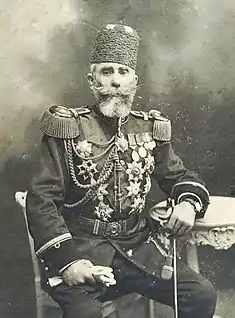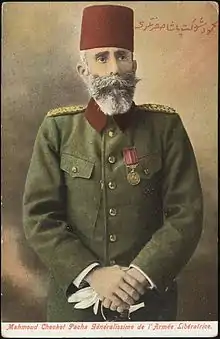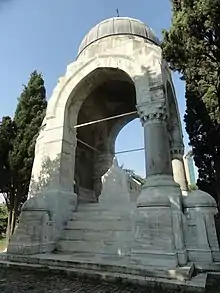Mahmud Shevket Pasha
Mahmud Shevket Pasha (1856 – 11 June 1913)[1] was an Ottoman generalissimo[2] and statesman of Chechen[3][4][5][6][7] or Circassian[8][9][10][11] origin who was an important political figure during the Second Constitutional Era. During the 31 March Incident, Shevket Pasha foiled Abdulhamid II's attempt to regain absolute power by organising the Action Army to suppress the anti-Constitutionalist uprising in Constantinople (modern Istanbul). Following the crisis Shevket Pasha was War Minister for a couple years, and played a leading role in establishing the Ottoman military aviation program. During the First Balkan War, he became Grand Vizier in the 1913 coup d'état, from 23 January 1913 until his death by assassination.
Mahmud Shevket | |
|---|---|
 | |
| Grand Vizier of the Ottoman Empire | |
| In office 23 January 1913 – 11 June 1913 | |
| Monarch | Mehmed V |
| Preceded by | Kâmil Pasha |
| Succeeded by | Said Halim Pasha |
| Minister of War | |
| In office 23 January 1913 – 11 June 1913 | |
| Monarch | Mehmed V |
| Grand Vizier | Himself |
| Preceded by | Nazım Pasha |
| Succeeded by | Ahmet İzzet Pasha |
| In office 12 January 1910 – 9 July 1912 | |
| Monarch | Mehmed V |
| Grand Vizier | İbrahim Hakkı Pasha Mehmed Said Pasha |
| Preceded by | Salih Hulusi Pasha |
| Succeeded by | Hurşid Pasha |
| Personal details | |
| Born | 1856 Baghdad, Baghdad Eyalet, Ottoman Empire |
| Died | 11 June 1913 (aged 56 or 57) Constantinople (now Istanbul), Ottoman Empire |
| Cause of death | Assassination |
| Resting place | Monument of Liberty, Istanbul |
| Alma mater | Mekteb-i Harbiye |
| Military service | |
| Allegiance | |
| Branch/service | |
| Rank | Field Marshal |
| Commands | Third Army Action Army |
| Battles/wars | Macedonian Struggle 31 March Incident Albanian Revolt of 1910 Yemeni Revolt First Balkan War |
Early life and career
Mahmud Shevket was born in Baghdad in 1856 to a lineage of Chechen exiles from Eastern Chechnya, belonging to either the Dishni or Alaroy teip;[12] his grandfather, Hacı Talib Ağa had moved from Tbilisi to Baghdad.[5] His father was Basra governor Kethüdazade Süleyman Faik Bey. Raised as an Ottoman, most sources claim that he had Chechen[3][4][5][6][7] or Circassian[13][14][15][16] ancestry. Some sources also claim he had Iraqi Arab,[17] or Georgian,[18]. In addition to (Ottoman) Turkish and Arabic, he spoke French and German.
He finished his primary education in Baghdad before going on to the Military Academy (Ottoman Turkish: Mekteb-i Harbiye) in Constantinople (now Istanbul).[19] Mahmud Shevket joined the army in 1882 as a lieutenant and rose through the ranks, eventually achieving the rank of Ferik (Lieutenant General) by 1901. He spent some time in France investigating military technology and was briefly stationed in Crete. He then returned to the Military Academy as a faculty member. He worked under Colmar Freiherr von der Goltz for a while and traveled to Germany. In 1905 Mahmud Shevket was appointed governor of the Kosovo Vilayet, during the height of the Macedonian Conflict.
31 March Incident
The Committee of Union and Progress (CUP) prevailed in the 1908 Young Turk Revolution, which forced the sultan Abdulhamid II to reinstate theOttoman constitution and call for elections. Mahmud Shevket Pasha was placed in command of the Selanik (Thessaloniki) based Third Army after the revolution. A year later saw the 31 March Incident, when counter-revolutionary reactionaries rose up in support of Abdulhamid's absolutist rule and the Constitution was once again repealed. The CUP appealed to Shevket Pasha to restore the status quo, and he organized the Action Army, an ad hoc formation made up of his Third Army and elements of the First and Second Armies to suppress the uprising.[20][21] His chief of staff during the crisis was the first president of the Republic of Turkey, captain Mustafa Kemal (Atatürk). The Action Army entered Constantinople (Istanbul) on 24 April, and after a series of negotiations, Abdulhamid II was deposed, Mehmed V Reshad ascended to the throne, the Constitution was reinstated for the third and last time, and the CUP was allowed to form a government. Thus started his complex and tenuous relationship with the "Sacred Committee".
War Minister
After the incident, he became an important power holder in Ottoman politics: Shevket Pasha was made Martial-law Commander of Constantinople, inspector of the First, Second, and Third Armies, a senator, and Minister of War. Though Hüseyin Hilmi Pasha came back to form a government, his premiership was widely seen as being under Shevket Pasha's control. His tenourship as War Minister saw the suppression of the 1910 Albanian Revolt. He also used troops from Tripolitania to suppress Yahya Muhammad Hamid ed-Din's revolt in Yemen, which exposed Tripolitania to foreign invasion from Italy in 1911.
Shevket Pasha is credited for the creation of the Ottoman Air Force in 1911. Shevket Pasha gave much importance to a military aviation program and as a result the Ottoman Air Force became one of the pioneering aviation institutions in the world.[22]
Though he saved the CUP in the 31 March Incident, Shevket Pasha also played a pivotal role in the 1912 coup which caused the fall of the CUP government. His resignation as War Minister was an effective endorsement to the Savior Officers, who were able to maneuver around the Unionist parliament and shuttered it, driving them underground.[23]
Premiership and assassination

During the First Balkan War, the Ottoman Empire lost all of its Balkan possessions except the outskirts of Constantinople. The CUP overthrew Kâmil Pasha's Savior Officer backed government in January 1913 in a coup known as the Raid on the Sublime Porte, because he entered negotiations with the Balkan League. In a move seen as a compromise by the CUP, Union and Progress entered cabinet again, while Shevket Pasha was made Grand Vizier, War Minister, and Foreign Minister and resumed fighting in the war. However the change in government did not change the reality that the war and most of Rumelia was lost. The Treaty of London ended the First Balkan War, though Shevket Pasha's government never signed the treaty.[25] The Ottoman Empire would recover Eastern Thrace and Edirne in the Second Balkan War, but by then Shevket Pasha would be dead.
On 11 June 1913 Mahmud Shevket Pasha was assassinated in his car in Beyazit Square in a revenge attack by a relative of the assassinated War Minister Nazım Pasha, who was killed during the 1913 coup.[1] He was buried in the Monument of Liberty, dedicated to soldiers of the Action Army who were killed in the 31 March Incident. The car he was in, the uniform he was wearing, the clothes of his murdered aides, and the weapons used in the assassination are all on display at the Istanbul Military Museum.
On the day of his assassination, deputy of the Freedom and Accord Party Lütfi Fikri stated "In the full sense of the word, Mahmud Şevket Pasha has committed suicide, and this was decided on the day he accepted the grand vezierate over the corpse of Nâzım Pasha. I am sure that this man did not like, for instance, Talaat Bey and his friends. How could it be that he became, to such a degree, a toy in their hands and died for this reason?"[26]
Legacy

Mahmud Şevket Pasha represented the last independent personality in the Empire's politics; the successor of the premiership, Said Halim Pasha, would be a puppet of the CUP's radical faction, headed by the triumvirate of Talat, Enver, and Cemal, all of whom would finally enter the cabinet following his death. Enver took Shevket Pasha's old post of Minister of War by 1914, and Talat in addition to returning to the interior ministry after his assassination, himself became Grand Vizier in 1917. Shevket Pasha's assassination allowed the CUP, primarily Talat Pasha, to establish a radically Turkish nationalist dictatorship that would last until the Ottoman Empire's defeat in World War I in 1918. This dictatorship would see the empire retake Edirne in the Second Balkan War, but also join and lose World War I while committing genocide against its Christian minorities.
The name of the town Tirilye was changed to Mahmutşevketpaşa in his memory after his assassination, but would rename itself to Zeytinbağı in 1963.[27]
A voice recording of Mahmud Shevket Pasha speaking to rally his troops against the counter-revolutionaries in 1909 was released by journalist Murat Bardakçı in 2012.[28]
Works
- Logaritma Cedâvili Risalesi (from Jean Dupuis, H. 1301)
- Fenn-i Esliha (H. 1301)
- Usûl-i Hendese I-II (H. 1302-1304)
- Asâkir-i Şahanenin Piyade Sınıfına Mahsus 87 Modeli Mükerrer Ateşli Mavzer üzer Tüfeği (H. 1303)
- Mükerrer Ateşli Tüfekler (H.1308), Küçük Çaplı Mavzer Tüfekleri Risâlesi (H. 1311)
- Küçük Çaplı Mavzer Tüfeklerine Mahsus Atlas (H.1311)
- Devlet-i Osmâniyye’nin Bidâyet-i Tesisinden Şimdiye Kadar Osmanlı Teşkilât ve Kıyâfet-i Askeriyesi” (I-III, H. 1320)
Gallery
 The pistols carried by Mahmud Shevket Pasha's assassins.
The pistols carried by Mahmud Shevket Pasha's assassins. The first automobile in Constantinople.
The first automobile in Constantinople. Mahmut Şevket Pasha just before his murder, Istanbul Military Museum.
Mahmut Şevket Pasha just before his murder, Istanbul Military Museum.
References
- David Kenneth Fieldhouse: Western imperialism in the Middle East 1914-1958. Oxford University Press, 2006 p.17
- Urazov, Fatikh. Generalissimusy mira XVI-XX vekov [Istoricheskiye portrety]. p. 58. ISBN 5-295-01270-0.
- Nâzım Tektaş, Sadrazamlar: Osmanlı'da ikinci adam saltanatı, Çatı Kitapları, 2002, p. .
- İsmail Hâmi Danişmend, Osmanlı Devlet Erkânı, Türkiye Yayınevi, İstanbul, 1971, p. 101. (in Turkish)
- Finkel, Caroline. (2007). Osman's dream : the history of the ottoman empire. New York: Basic Books. p. 57. ISBN 978-0-465-00850-6. OCLC 756484323.
- Mango, Andrew. (1999). Atatürk. London: John Murray. p. 549. ISBN 0-7195-5612-0. OCLC 41547097.
- "Чеченский генералиссимус Турции Махмуд Шевкет-Паша". ИА Чеченинфо (in Russian). Retrieved 16 June 2020.
- Süren, Zafer. “Bir Sizden Bir Bizden”; Hep Bizden!
- Nevşin Mengü Soruyor | Konuklar: İlber Ortaylı ve Erinç Sağkan, Deutsche Welle
- Kafkasya Gerçeği, Nisan 1993, Sayı 12.
- Önemli Çerkezler, Özgür Kafkasya Dergisi, sayı 27.
- "Чеченцы в военной элите Османской империи - Турции".
{{cite web}}: CS1 maint: url-status (link) - Süren, Zafer. “Bir Sizden Bir Bizden”; Hep Bizden!
- Nevşin Mengü Soruyor | Konuklar: İlber Ortaylı ve Erinç Sağkan, Deutsche Welle
- Kafkasya Gerçeği, Nisan 1993, Sayı 12.
- Önemli Çerkezler, Özgür Kafkasya Dergisi, sayı 27.
- Ali Bilgenoğlu, Osmanlı Devleti'nde Arap milliyetçi cemiyetler, Müdafaa-i Hukuk Yayınları, 2007, p. 87.]
- "The New York Times, May 17, 1909" (PDF). The New York Times. 17 May 1909.
- Finkel, Caroline, Osman's Dream, (Basic Books, 2005), 57; Istanbul was only adopted as the city's official name in 1930...
- Gawrych 2006, p. 167.
- Zürcher 2017, p. 202.
- "Archived copy". Archived from the original on 7 October 2011. Retrieved 6 November 2011.
{{cite web}}: CS1 maint: archived copy as title (link) - Shaw & Shaw 1977, p. 291.
- "Archived copy". Archived from the original on 4 March 2016. Retrieved 5 September 2013.
{{cite web}}: CS1 maint: archived copy as title (link) - Feroz Ahmad (2014). Turkey: The Quest for Identity (second ed.). London: Oneworld. p. 44. ISBN 978-1-78074-301-1.
- Keiser 2018, p. 140.
- "Adına kavuşan belde Tirilye". Sabah. Türkçe. Archived from the original on 30 January 2012. Retrieved 6 October 2020.
- Archived at Ghostarchive and the Wayback Machine: "Mahmud Şevket Paşa'nın 31 Mart Olayı Sırasındaki Ses Kaydı". YouTube.
Sources
- Kieser, Hans-Lukas (2018). Talaat Pasha: Father of Modern Turkey, Architect of Genocide. Princeton University Press. ISBN 978-0-691-15762-7. (Google Books)
- Shaw, Stanford; Shaw, Ezel (27 May 1977), History of the Ottoman Empire and Modern Turkey, vol. II, Cambridge University Press (published 1975), ISBN 0-521-29166-6
.svg.png.webp)